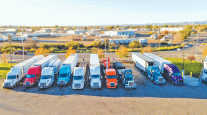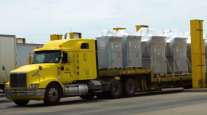Freight Rates Rise Despite Flat Cargo Volumes as Carriers Match Capacity to Shipper Demand
This story appears in the Sept. 19 print edition of Transport Topics.
NEW YORK — Motor freight rates remain on the rise, climbing at much as 10%, despite generally stagnant cargo volumes, as carriers focus on pricing and effectively match capacity to demand, six top industry officials said at a recent investment conference.
The rate increases of 3% to 10% excluded fuel surcharges and were on a year-over-year basis, said executives of Landstar System Inc., Old Dominion Freight Line Inc., ABF Freight System Inc., Con-way Inc., Saia Inc. and Celadon Group Inc.
Supporting their individual comments, the latest American Trucking Associations’ trucking activity report, issued last week, showed revenue growth for both truckload and LTL carriers topped 5% in July and more than 6% so far this year.
All six companies are on the Transport Topics Top 100 list of the largest U.S. and Canadian for-hire carriers, with Con-way the largest at No. 3.
“We haven’t felt anything that is negative at all,” said Henry Gerkens, CEO of Landstar System Inc., Jacksonville, Fla., “but there is so much negativity in the news that we hope it does not turn into a self-fulfilling prophecy.”
The executives spoke Sept. 8 at the Dahlman Rose investor conference here. Their comments about the economy echoed the views of shippers and railroad officials who made similar observations about freight markets the day before (9-12, p. 3).
Landstar’s revenue per load is up about 7% over the past four months, and loads from continuing businesses are running ahead of 2010, Gerkens said. Pricing for flatbed freight, which accounts for 33% of revenue, is particularly strong.
The largest rate increase was at Arkansas Best Corp., Fort Smith, Ark. “The pricing environment is much improved” as evidenced by 10% third-quarter growth, CEO Judy McReynolds said.
At the same time, tonnage has slipped behind last year at its ABF unit, she said.
Despite the recent increases, several executives noted that pricing still remains below prerecession levels.
One of those who made that observation was Stephen Bruffett, chief financial officer of Con-way Inc., Ann Arbor, Mich.
Bruffett said Con-way’s less-than-truckload unit has raised rates about 8% over the past four months, although tonnage levels have dropped about 6%, because the company wants to make the best match of freight volumes and service levels. Con-way’s truckload carrier has raised rates about 4% this year, he said.
“Since July, freight has been a little softer than what we expected,” Bruffett said. “If you had asked me in May and June, I would have said it would be higher. But it still hasn’t fallen off a cliff.”
Wes Frye, chief financial officer at Old Dominion, Thomasville, N.C., reported rates rose 8% in July and August and are expected to increase 6% to 7% for the full year. Tonnage was up nearly 8% in July and topped 10% growth last month, he said.
Saia Inc., Johns Creek, Ga., has seen rates rise 4% to 5%, Chief Financial Officer James Darby said.
Celadon CEO Stephen Russell did not specify the extent of current rate increases, though prices improved 4% in the second quarter.
Other truckload carriers that reported rate improvement over the past week in investor calls were Swift Transportation Inc. and Knight Transportation Inc.
While the rate picture was favorable, not every company was upbeat about truckload business.
John Roberts, CEO of J.B. Hunt Transport Services Inc., Lowell, Ark., said the carrier continues to focus on boosting margins rather than expanding the truckload market and to evaluate its long-term presence in that market while focusing on growing intermodal, dedicated and brokerage service.
“We need a bit of help from the economy,” Roberts said. “The driving force is to improve returns on invested capital. It’s a tall hill to climb. If we don’t see improvement, we will modify our approach to the trucking business. That is somewhat farther down the road.”
Roberts also said Hunt intends to increase its brokerage business to generate $1 billion in revenue, about triple the 2011 pace.
While Hunt’s CEO questioned truckload’s future, Con-way’s truckload unit is buying 2,100 tractors this year and next to bring down its fleet age to 1.6 years from about 2 years today, said Bruffett.
Several carriers also showed signs of active interest in acquisitions and expansion.




